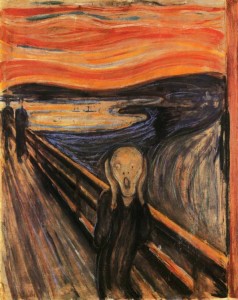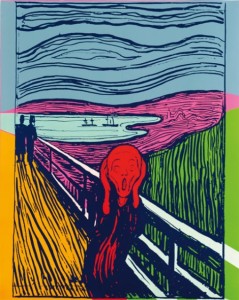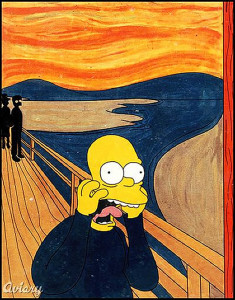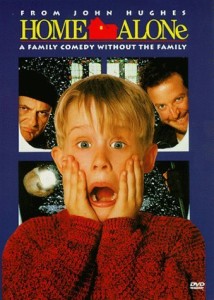Teach close reading skills, parodies, and Post-Impressionism with Edvard Munch’s The Scream
 Edvard Munch’s The Scream in the the collection of the National Gallery and Munch Museum, Oslo, Norway. Visit their website for detailed information. Click on the painting for a high quality image that can be magnified.
Edvard Munch’s The Scream in the the collection of the National Gallery and Munch Museum, Oslo, Norway. Visit their website for detailed information. Click on the painting for a high quality image that can be magnified.
I was walking along the road with two friends. The sun set. I felt a tinge of melancholy. Suddenly the sky became a bloody red. I stopped, leaned against the railing, dead tired. And I looked at the flaming clouds that hung like blood and a sword over the blue-black fjord and city. My friends walked on. I stood there, trembling with fright. And I felt a loud, unending scream piercing nature.
— Edvard Munch on the experience that inspired his painting The Scream
Look at The Scream. Before reading the quote above, tell students the title and ask what is going on in this picture? See how much students can decipher through a discussion. Encourage students to identify the evidence that supports their reasoning. Students should likewise be encouraged to share wonderings and voice confusions. As the conversation slows, explain you are going to read a quote from the artist that describes the experience that inspired this painting. After reading the quote ask how does this new insight change your understanding of the painting?
Begin with Art History
The Scream by Edvard Munch was painted in 1893 during a transitional period in art history. It was painted at the end of a Realism period, when artists showcased their technical skills creating very precise, photograph-like paintings, and before Expressionism, when artists focused on their inner feelings and emotions. Like other Post-Impressionists such as Paul Gaugin and Vincent van Gogh, Munch used rich colors and vibrant swirling brush strokes to convey his emotions and state of mind.
Edvard Munch is a Norwegian artist whose traumatic childhood influenced his paintings and worldview. When he was young, his mother and a favorite sister died of tuberculosis. Another sister was diagnosed with mental illness. While his father tried to be supportive, he was considered “temperamentally nervous and obsessively religious.” As Munch explained, “I inherited two of mankind’s most frightful enemies—the heritage of consumption and insanity—illness and madness and death were the black angels that stood at my cradle.” Ongoing alcoholism and overwhelming anxiety haunted Munch throughout much of his career filling his work with torment, melancholy, and emotional angst.
For as long as I can remember I have suffered from a deep feeling of anxiety which I have tried to express in my art. Without anxiety and illness I should have been like a ship without a rudder.
— Edvard Munch describing how personal anxiety and illness influenced his work
Look Like an Art Critic
This image of The Scream from the National Gallery and Munch Museum, Oslo, Norway can be magnified to show exquisite detail. Look at The Scream. What do you notice? What does it make you think of? Turn and talk to share your initial perceptions.
The Composition and Lines
Point out and discuss: The composition is organized around an upside down triangle. The railing creates one leg of the triangle, the horizon line is the base of the upturned triangle, and dark line at the base of the hill creates the final leg of the triangle that converges on the screamer. A series of smaller secondary lines ripple out from and swirl around these primary lines. The screamer, the figures in the background, and the boats near the horizon line are points in a secondary, but parallel triangle. How does this composition and its use of line amplify the scream?
Turn, Talk, and Report Back (Possible answers: The legs of the triangle makes your eyes focus in on the screamers mouth. The triangle composition could be seen as a megaphone directing the sound out to the world. The swirling lines enhance the sense of energy radiating out from the scream. They ripple away from the triangle like an echo. Frenzied curvy lines suggest emotional anxiety. The figures on the bridge, and the boats further in the background create a sense of space and distance, extending the reach and magnitude of the scream.)
The Colors
Point out and discuss: Like Gauguin and van Gogh, Munch used saturated colors and broad brushstrokes for impact and to evoke his inner emotional state. While the sky seems unnaturally vibrant, it may have been inspired by the vibrant sunsets caused by the volcanic dust from the eruption of Krakatoa in Indonesia a decade earlier. What do the colors make you think of and how do they amplify the scream?
Turn, Talk, and Report Back (Possible answers: The sky looks bloody and on fire which is unsettling. The darkness of the landscape is likewise mysterious and unpredictable, lacking recognizable details. The sharp contrasting colors of the sky and the ground are visually jarring, intensifying the visual discord and sense of anxiety. The unnaturally vibrant colors energize the landscape, making everything swirl and clash with greater intensity, screaming off the canvas.
The Characters
Point out and discuss: Who is the screamer? It is hard to say because the screamer lacks identifiable features that would suggest age, race, gender, or social standing. Some have interpreted the screamer as Munch himself, others believe it depicts the cries from the local insane asylum that housed his sister or the wailing of animals in a nearby slaughterhouse. Or is it a symbol of growing anxiety caused by an alienating modernization? And who are the figures on the walkway? Their clothing suggests they are men but are they walking away, a literal depiction of Munch’s friends on the walk or a symbol of abandonment. Or, are these dark figures walking toward him, looming above and judging him? How does the ambiguity of the figures and their relationship to each other enhance the picture? How do you interpret this painting?
Turn, Talk, and Report Back (Possible answers: The lack of detail fits the abstract landscape. The ambiguity make the images more universal and opens the painting to the viewer’s interpretation, reflecting their own world view.)
Think Like an Artist
The Scream has become a universal symbol of anxiety, alienation, and emotional turmoil and has inspired parodies by artists and popular culture alike, such as
- Erró’s “The Second Scream”
- Andy Warhol’s screenprint “The Scream (After Munch)”
- The Homer Scream by meowza
- The promotional poster for Home Alone
- Brigitte Sleiertin’s Halloween mask was made famous in Wes Craven’s Scream movies





Consider how recreating The Scream with nontraditional pigments or a collage of small images would impact your interpretation of the piece? What if you recreated the image with toothpaste or other cosmetic gels how would that inform the work? The aroma of the chosen cosmetic would add another element to the piece. What if you used smiley face stickers? Or small photographs from the news (what kinds of images would you collect)? What things make you scream and how could you express that through this composition? If you try this activity I would love to see what you do.
Life Lesson
Amplify your essence. During his early years Munch experimented with many different artistic styles and genres. He especially bristled at Impressionism’s sterile and scientific approach to painting. It was only after a period of self-reflection and exploration into his own psychological state that his original style began to crystallize. The Sick Child (1886), a painting based on his sister’s death marked his first break from Impressionism. By 1892 Munch’s paintings had tapped into the melancholy and emotional turmoil that consumed him. He drew on personal experiences and feelings to express universal themes. While angst is not a comfortable place for most people to go, it is what Munch knew well and where he found his voice. One thing creative souls can learn from Munch is to focus on those essentials that make you unique and then turn up the volume. Your work, like Munch’s, may face harsh critiques, but it will at least be something you like and believe in.
Related videos
- Art History Online (9:40) gives an in-depth overview of The Scream.
- The Post-Impressoinist – Munch (48:01) An overview of the artist’s life.
Integrating into Your Curriculum
Artists oftentimes use common visual strategies or signposts to alert viewers to significant details in their art. Here are some ideas for using these visual signposts to unpack a work of art. Remember, the close reading skills in art appreciation are similar to the close reading practices taught in reading.
What piece of literature would you partner with The Scream?
How would you use this painting to elaborate on one of your units of study? Please share if you have other ideas on how to teach The Scream by Edvard Munch as an English/language arts lesson plan.
